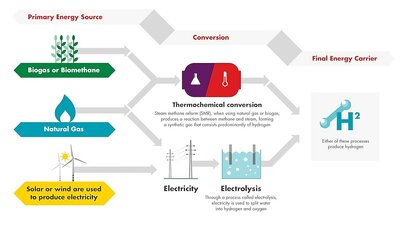Hydrogen Fuel For Cars and Trucks Coming Up Fast - Shell Tutorial
 |
SEE ALSO: Hydrogen Fuel News and Opinion Archive
Hydrogen Fuel
Hydrogen is one of the most abundant elements in the universe and could play a significant role in the transition to a clean and low-carbon energy system. Shell has a growing network of hydrogen stations in Europe and in North America, where it is part of several initiatives to encourage the adoption of hydrogen in transport.
How hydrogen is produced
Hydrogen is abundant but is rarely found in its pure form. It has to be produced through chemical reactions. Around 99% of hydrogen today is produced through fossil-fuel reforming, a process that produces a reaction between natural gas and steam. Hydrogen can also be produced from renewable sources, using biogas, a gaseous form of methane obtained from biomass, or through electrolysis using electricity generated by renewable sources.
Here’s how each of these processes work:
Can hydrogen be used to power cars and buses?
Hydrogen can be used to power a number of different types of transportation. It can be stored and transported at high energy density in liquid or gaseous form, and it can be used as a fuel for power or in transport, and in industry as feedstock.
Yes. Just like battery-electric vehicles, hydrogen fuel cell electric vehicles (FCEVs), including passenger cars and buses, are powered by electricity and so produce no carbon dioxide (CO2) or other harmful emissions from their tailpipe – only water vapour. In these vehicles, energy is stored in the form compressed hydrogen fuel, rather than in a battery.
The hydrogen fuel-cells convert compressed hydrogen from their fuel tanks into electricity that powers the electric motor in the vehicle, providing a similar range to vehicles powered by internal combustion engines using gasoline or diesel.
Hydrogen-powered cars also have the advantage of being able to cover long distances, and only take a few minutes to refuel at a retail site.
How does hydrogen scale up to play a role in a lower-carbon future?
Collaboration between vehicle manufacturers, energy companies and government is vital for progressing the infrastructure to make any emerging fuel a viable alternative. Hydrogen is no exception.
In Germany, we are part of a joint venture called H2 Mobility with industrial gas manufacturers, Air Liquide and Linde', car manufacturer, Daimler, and energy companies, Total and OMV, to develop a nationwide network of hydrogen refuelling stations. Learn more about H2 Mobility and it’s live information from public hydrogen stations all across Europe here.
In the USA, Shell has four hydrogen filling stations in California and is currently working in partnership with Toyota, with the support of the State of California, to further develop its hydrogen refuelling network. We are also developing hydrogen stations in the UK, in the Netherlands, and in Canada.
Can hydrogen be used in heavy duty transport?
It can. The high energy density of hydrogen makes it particularly suitable for trucks, trains and potentially ships, which carry heavy goods over long distances.
Since 2018, Shell has been part of a Californian consortium to develop three new large-capacity refuelling stations for heavy-duty hydrogen fuel-cell trucks being developed by Toyota and Kenworth Truck Company. One of these stations will use hydrogen made from biogas, which is natural gas made from renewable sources.
These stations will form the first hydrogen truck refuelling network in California, and will help to reduce emissions along a heavily-polluted road that connects the Port of Los Angeles and a major warehouse complex inland.
The future of Hydrogen
In 2017, Shell published a study on the future of hydrogen in the transport sector, jointly produced with the Wuppertal Institute for Climate, Environment and Energy.
The study concludes that in 2050, 113 million fuel cell electric vehicles (FCEVs) could save up to 68 million tonnes of fuel and almost 200 million tonnes of carbon emissions, making a significant contribution to reducing energy consumption and greenhouse gas emissions in the transport sector.



